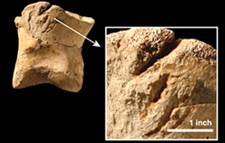
T. rex was the only big carnivore in western North America 65 million years ago that was capable of making such large gouges. Image credit: Nicholas Longrich
It turns out that the undisputed king of the dinosaurs, Tyrannosaurus rex, didn’t just eat other dinosaurs but also each other. Paleontologists from the United States and Canada have found bite marks on the giants’ bones that were made by other T. rex, according to a new study published online Oct. 15 in the journal PLoS ONE.
While searching through dinosaur fossil collections for another study on dinosaur bones with mammal tooth marks, Yale researcher Nick Longrich discovered a bone with especially large gouges in them. Given the age and location of the fossil, the marks had to be made by T. rex, Longrich said. “They’re the kind of marks that any big carnivore could have made, but T. rex was the only big carnivore in western North America 65 million years ago.”
It was only after discovering the bite marks were from a T. rex that Longrich realized the bone itself also belonged to the behemoth. After searching through a few dozen T. rex bones from several different museum fossil collections, he discovered a total of three foot bones (including two toes) and one arm bone that showed evidence of T. rex cannibalism, representing a significant percentage.
“It’s surprising how frequent it appears to have been,” Longrich said. “We’re not exactly sure what that means.”
The marks are definitely the result of feeding, although scientists aren’t sure whether they are the result of scavengers or the end result of fighting, Longrich said, adding that if two T. rex fought to the death, the victor might have made a meal out of his adversary. “Modern big carnivores do this all the time,” he said. “It’s a convenient way to take out the competition and get a bit of food at the same time.”
However, the marks appear to have been made some time after death, Longrich said, meaning that if one dinosaur killed another, it might have eaten most of the meat off the more accessible parts of the carcass before returning to pick at the smaller foot and arm bones.
While only one other dinosaur species, Majungatholus, is known to have been a cannibal, Longrich said the practice was likely more common than we think and that closer examination of fossil bones could turn up more evidence that other species also preyed on one another.
The finding is a big clue into the obscure eating habits of these enormous predators. While today’s large carnivores often hunt together in packs, T. rex likely acted on their own, Longrich said. “These animals were some of the largest terrestrial carnivores of all time, and the way they approached eating was fundamentally different from modern species,” he said. “There’s a big mystery around what and how they ate, and this research helps to uncover one piece of the puzzle.”
Other authors of the paper include John Horner (Montana State University), Gregory Erickson (Florida State University) and Philip Currie (University of Alberta).
*Source: Yale University
